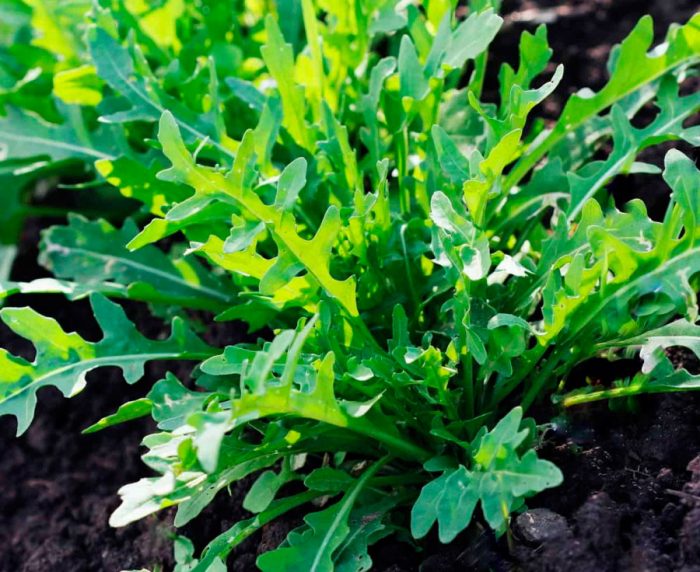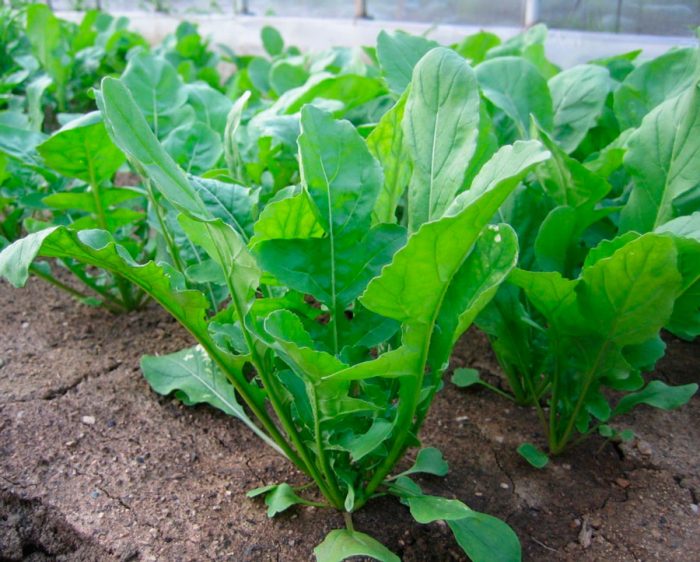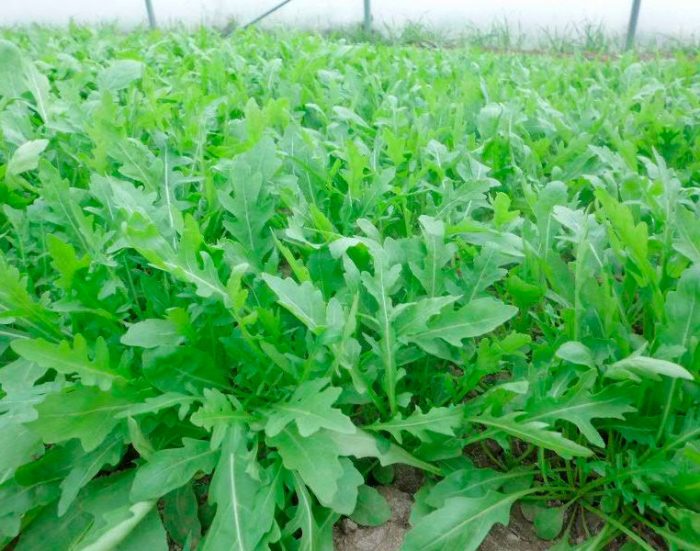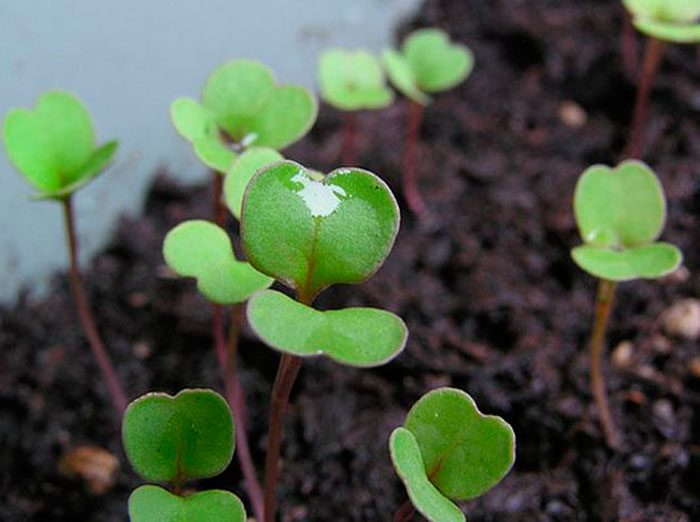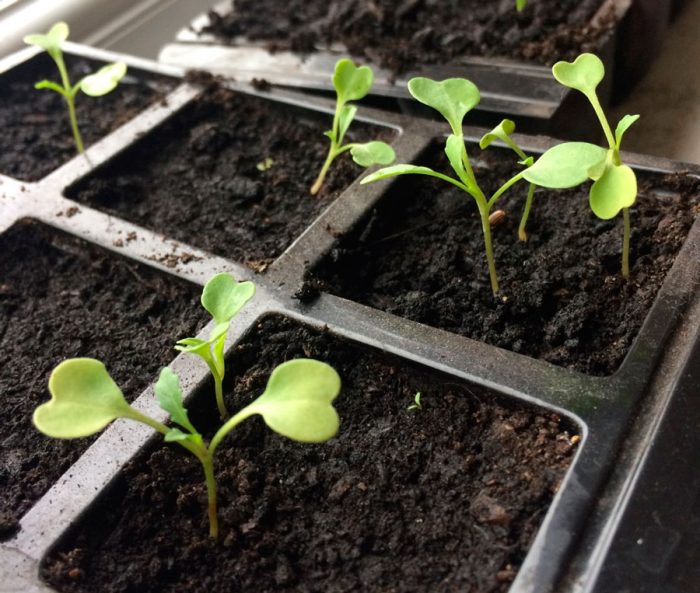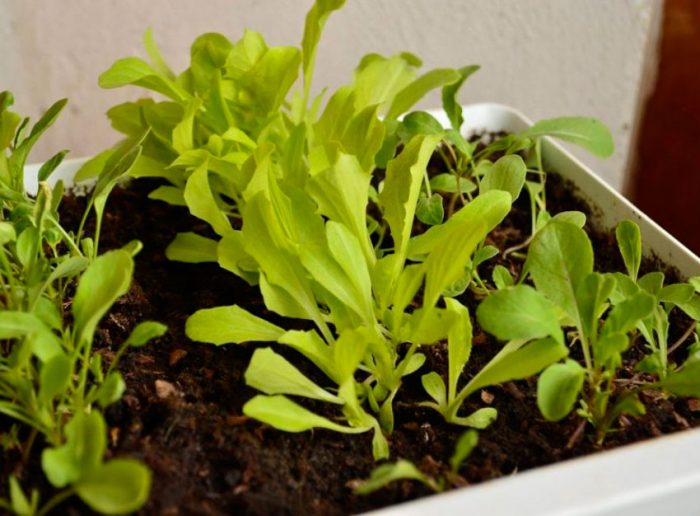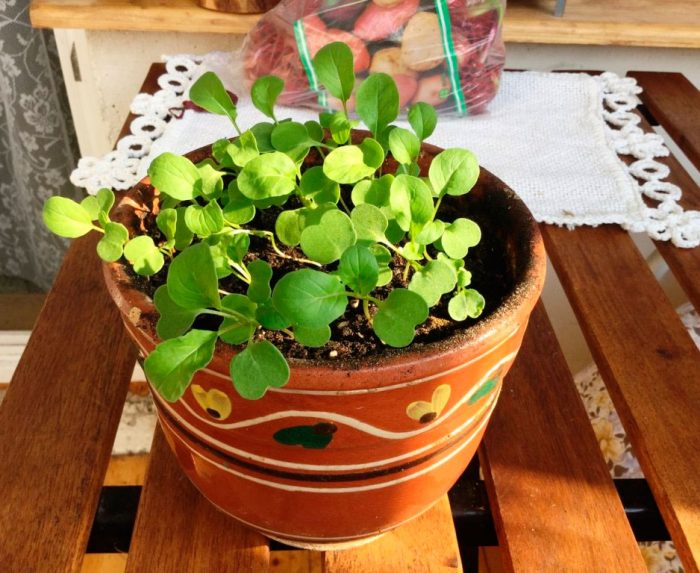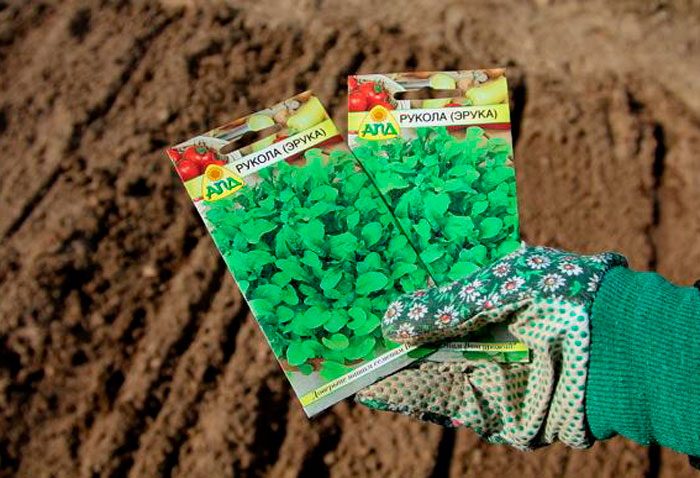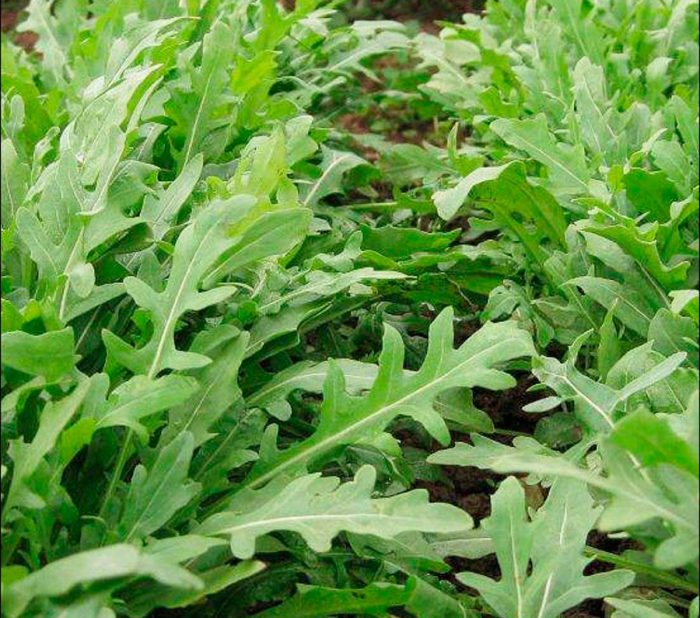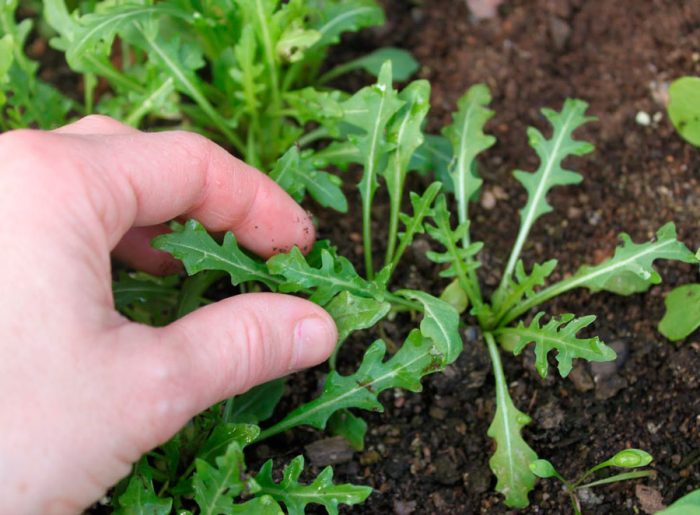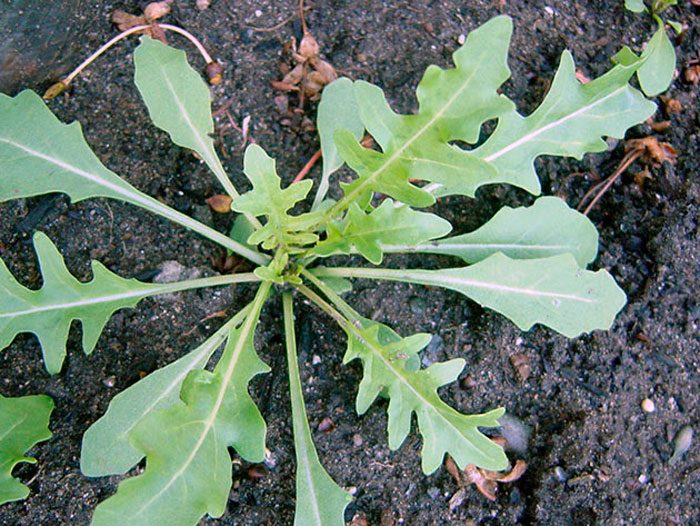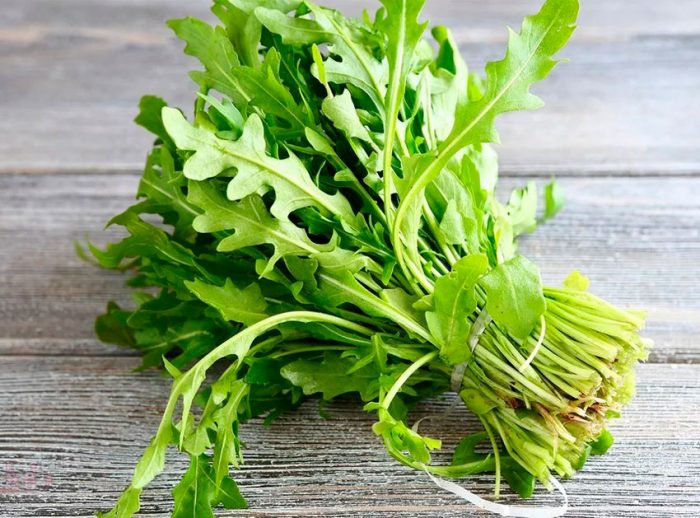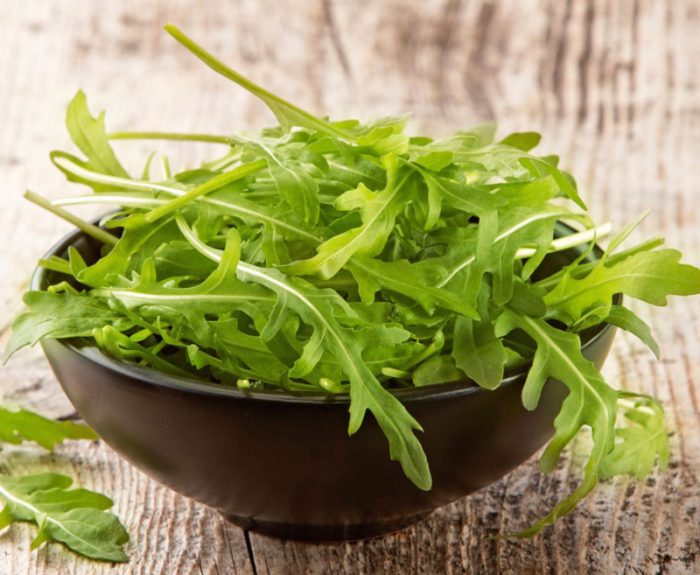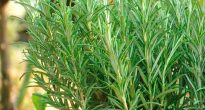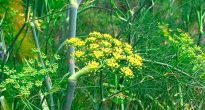The herbaceous annual arugula (Eruca sativa), either Indau, or mustard, or rocket salad, or seed caterpillar, or Arugula, or Eruka, is a member of the Indau genus of the Cabbage family. Under natural conditions, it is found in Asia (in India, as well as from Asia Minor to Central Asia), in Central and Southern Europe, and also in the northern part of Africa. Arugula is widely cultivated in Italy, but it is popular in other countries, for example, in America and in northern Europe. For a long time, this culture was considered an aphrodisiac, and the first mention of it dates back to the first century BC. In Egypt, arugula was placed in pea and bean dishes to improve their taste, while in ancient Rome it was used as a spice, adding to dishes made from meat and vegetables. To date, scientists have found that this plant has unique medicinal properties.
Content
Brief description of cultivation
- Landing... Sowing seeds in open soil is carried out in April, and for seedlings - in the first days of March. Seedlings are planted in open ground in April.
- Illumination... In the morning it needs diffused light, and in the afternoon it needs shading.
- Priming... It should be nutritious, not too dry, neutral or slightly alkaline.
- Watering... It needs frequent systematic watering, make sure that the soil on the site is always slightly damp (not damp). During dry and hot seasons, watering should be done every day.
- Fertilizer... It is not necessary to feed, however, during the season, the surface of the beds is mulched several times with a layer of old peat or humus.
- Reproduction... Seeds.
- Harmful insects... Cabbage moths and cruciferous fleas.
- Diseases... Fusarium and peronosporosis.
- Properties. This plant is classified as dietary, it contains a large amount of biologically active substances and vitamins.
Features of arugula
The height of arugula varies from 0.3 to 0.6 m. There is a slight pubescence on the straight, branched stem. Succulent leaf plates, as a rule, are sparsely hairy, but sometimes they are bare, they have a specific nutty smell.The lower foliage has a dissected or lyre-pinnate shape with serrated lobes along the edge. Rare long racemose inflorescences are formed in May, they are composed of light yellow or rich yellow flowers with veins of purple color. The fruit is a pod, in which seeds of light brown or pale brown color are placed in 2 rows.
Planting arugula for seedlings
What time to sow
Arugula is grown from seeds, using both seedling and non-seedling methods. In the suburbs and in regions with a warmer and milder climate, sowing seeds is carried out directly into open soil in April. In areas where it is quite cool in spring, it is recommended to grow such a crop through seedlings, while sowing seeds is carried out in early March.
Sowing
You can fill the seed containers with soil from the area where the arugula will then be grown. But remember that before sowing, the soil must be disinfected, for this it is spilled with freshly boiled water or ignited in an oven. Also, to fill the containers, if desired, you can use the purchased ready-made soil mixture for vegetable seedlings. When 2-3 hours remain before sowing, the seed is poured with a pinkish solution of potassium permanganate. The depth of the selected box or container must be at least 10 centimeters, it is filled with prepared soil, which is pre-moistened. Level its surface and evenly distribute the seeds on it, maintaining a distance between them from 15 to 20 mm. They are sprinkled on top with a centimeter layer of sand, after which the crops are transferred to a well-lit place, while you do not need to cover them from above.
Seedling care
Under favorable conditions, seedlings appear amicably and only 3-5 days after sowing. It is very simple to care for the seedlings, for this it is systematically watered abundantly and the soil surface near the bushes is loosened. The pick is carried out after two true leaf plates are formed in the plants. To do this, they are planted in 2 pieces in peat pots, or the seedlings can be transplanted into a larger box, while the distance between them should be from 10 to 15 centimeters, with a row spacing from 25 to 30 centimeters. Experienced gardeners say that thanks to such a spacious planting, the foliage in adult bushes will have a rich characteristic smell and taste.
Growing arugula on the windowsill
In order for you to have healthy fresh greens in winter, arugula can be grown indoors. For sowing seeds, a soil mixture of a neutral or slightly alkaline reaction is used; for its preparation, it is necessary to combine humus, sod soil and sand (2: 2: 1). Before proceeding to sowing, the soil mixture is disinfected, for this it is spilled with freshly boiled water or placed in an oven for calcination.
For sowing arugula, you can use containers or boxes, but if you plant it in a pot, then it will not only delight you with fresh herbs, but will also decorate any room. Take a container, at the bottom of which there are holes for drainage, on its bottom lay a layer of pebbles, pieces of brick or expanded clay 20–30 mm thick. Then the container is filled with a moistened soil mixture, its surface is leveled and slightly compacted, after which the seeds are sown (just like when sowing for seedlings).
Watering
When growing arugula in room conditions, it must be systematically and often watered (once every two days), since the soil mixture in the container should be slightly damp all the time. Also, the bushes should be regularly moistened with clean water from a spray bottle. And remember that if arugula feels a lack of water, then the taste of its foliage will become bitter.
Thinning
The surface of the substrate near the bushes must be systematically carefully loosened.After 7-10 days have passed since the seedlings appear, it will be necessary to thin them out, while pulling out all the weak and lowest plants, you can make a delicious salad from them. The temperature at which mustard grass grows and develops best on the windowsill is about 18 degrees.
Fertilizer
If the bushes grow in a nutrient-rich soil mixture, then they can not be fed. But some gardeners argue that they still need to be fed with nitrogen fertilizer. To prepare the nutrient mixture, take 10 grams of fermented mullein or chicken droppings and dilute with water 10-15 times. The resulting mixture is combined with 10 liters of water and everything is thoroughly mixed. Since the ripening period of the crop is short, it is not recommended to feed it with mineral fertilizers or manure, because this can cause toxins to accumulate in the foliage.
Growing arugula outdoors
Landing in open ground
Arugula seedlings are planted in open soil in April after the air warms up to 9-10 degrees. A well-lit open area for growing it is not suitable, as well as a shaded area. An area is ideal for planting it, which is well lit until noon, and then is in partial shade until about 16 o'clock.
Best of all, such a culture will grow on neutral or slightly alkaline soil. Good predecessors for her are tomatoes, potatoes, carrots, as well as pumpkin and legumes. And in those areas where representatives of the Cabbage family were grown before arugula, namely, various types of cabbage, radishes, radishes, rutabagas, horseradish, turnip and daikon, arugula should not be grown for at least three years. When growing seedlings in peat pots, they are planted in the soil directly in them. And if a box, a separate cup or container was chosen for planting it, then the plant is carefully pulled out of them along with a large earthen clod. When planting seedlings, they adhere to a 10x30 centimeters scheme. Do not forget to moisten the prepared pits before planting. And when the plants are planted, they must be watered well.
Arugula is a frost-resistant plant, and it is not afraid of frosts down to minus 7 degrees. However, if a stronger frost is expected, then the bed should be covered overnight with a film that is removed in the morning. Instead of a film, each plant can be covered with a cut plastic bottle.
Basic rules of care
Arugula is grown in the open field in much the same way as a salad. To do this, she is provided with timely watering, weeding, as well as loosening the soil surface in the aisles and around the bushes. If the plantings are excessively dense, they must be thinned out, otherwise the characteristic smell and taste of the foliage becomes less pronounced. It should be remembered that in the summer months, during a prolonged dry sultry period, the bushes can begin to bloom, and this has an extremely negative effect on the taste of the foliage.
How to water
The main rule of successful cultivation of mustard grass on the site is moist and loose soil. In this regard, the bushes should be watered regularly, often and abundantly. Also, special attention is paid to loosening, which is carried out every time after the rain has passed or the bed is watered, weeding is carried out at the same time. During an extended hot dry season, the frequency of watering is increased and the area is moisturized every day. Arugula can be watered by sprinkling, or a hose is laid on the soil surface and the aisles are well filled with plenty of water.
Harvesting
You can pick foliage for food after its height reaches 10 centimeters. If it outgrows, it will become rough and lose its taste. From the appearance of the seedlings to the first harvest, it takes three to five weeks.
Top dressing
There is no need to feed the culture.However, in order to increase the nutritional value of the soil, it is recommended to mulch it several times per season with a thin layer of humus or old peat.
What can be grown after arugula
Almost every gardener or gardener tries to adhere to the rules of crop rotation, which are very important for maintaining the health of crops. Therefore, you should know that arugula is a good precursor for pumpkins and legumes, as well as potatoes and carrots. But crucifers in this area cannot be grown for at least three years, since they have common diseases and pests with arugula.
Pests and diseases of arugula
Diseases
If arugula is affected by peronosporosis (downy mildew), then specks of brown color are formed on its leaf plates. If the bush hits Fusarium, then its foliage will turn yellow, while its vascular system will turn brown or black. Adult diseased bushes can no longer be cured, so they are dug up and burned, and another site is chosen for planting a new arugula, while the soil on it is prepared with special care. In order to prevent these diseases, it is necessary to adhere to the rules of crop rotation and promptly remove weeds from the site.
Harmful insects
When grown in open soil, the cabbage moth can settle on the bushes, but the cruciferous flea is the greatest danger to the culture, as to all members of the Cabbage family. Both of these pests gnaw holes in the foliage.
In order to prevent the appearance of a flea in the garden with arugula immediately after the seedlings are planted on the site, it is covered with a non-woven material (for example, agrospan). You can also sprinkle the plant on top with ground red pepper, tobacco dust or wood ash. To get rid of the cabbage moth, it is recommended to spray the bushes with an infusion of wormwood, and also tops of a tomato or potato. For prevention purposes, during the preparation of the site for planting, it must be dug up.
Types and varieties of arugula
Among all types of arugula, both annuals and biennials are found. When a two-year-old species is grown, its root hibernates well in the ground, and with the onset of spring, juicy greens grow in it. The most popular is such a biennial as arugula Solitaire: this variety is mid-season, the bush reaches about 20 centimeters in height, the average size of dissected lyre-shaped leaf plates along the edge have incisions, their taste is nut-mustard. The ripening period for this variety is from 35 to 45 days.
The most popular annual varieties include the following:
- Dikovina... The height of the bush in such a mid-season variety is about 20 centimeters, the foliage has a lyre-like shape. The ripening period of this variety is from 22 to 25 days.
- Arrows of Cupid... In this variety of average ripening, the height of the bushes can vary from 0.2 to 0.3 m.The foliage is narrow and long, and the flowers are yellowish. The ripening period is from 35 to 38 days.
- Olivette... An early ripe variety with bushes 15 to 20 centimeters high. The taste of juicy foliage is nutty-mustard, it contains a large amount of vitamins, carotene and essential oils. The variety ripens in 20-25 days.
- Rocket... The height of the bushes in this early variety is from 15 to 20 centimeters. The dark green pinnately dissected leaf plates have a mustard-nut flavor. The ripening period is from 20 to 25 days.
- Poker... This early ripe variety has bushes about 20 centimeters high. Large leaf plates are distinguished by a slightly sweet mustard taste, the color of the flowers is light cream. The ripening period is 22-28 days.
- Victoria... Lush low bushes have a dietary flavor foliage that contains a large amount of vitamins. Ripening duration - 20-25 days.
- Spartacus... The height of the bushes in this early-maturing dietary variety is about 22 centimeters.Spicy foliage contains a large amount of essential oils and vitamins. Ripening of the variety lasts from 20 to 25 days.
Still popular varieties of arugula are: Sicily, Corsica, Euphoria, Taganskaya Semko and Rococo.
Arugula properties: harm and benefit
Medicinal properties of arugula
Healers have used arugula oil for a long time in the treatment of boils, sprains, bruises and headaches. Today, this culture is widely used for the care of problem skin, in the treatment of dermatitis, as well as for whitening freckles and removing age spots. This plant contains vitamin A (beta-carotene), B vitamins, vitamins C, K and E, as well as zinc, selenium, magnesium, manganese, copper, phosphorus, sodium and iron. Due to the biological activity, such a plant has a beneficial effect on the digestive processes and on the work of the digestive tract. It increases the amount of hemoglobin in the blood, and lowers the sugar level, fights against pathogenic bacteria and viruses, has a beneficial effect on immunity and is involved in the regulation of water-salt metabolism. Since it contains vitamin K, which increases blood clotting and accelerates wound healing, it is recommended for those who have venous disease or high blood pressure.
Arugula has a diuretic, lactogonic and expectorant effect. American specialists successfully use it in the treatment of gastritis and stomach ulcers, as it helps to protect and strengthen the walls of the stomach. It is also a dietary food because it contains a lot of fiber. For people who follow a strict diet, experts advise including arugula in their daily diet, as it helps to maintain performance and energy throughout the day. Another good thing about mustard grass is that it contains very few calories, so 100 grams of the product has only 25 kilocalories. The mustard oil in arugula helps to strengthen hair, improve its structure and prevent hair loss.
Contraindications
Since arugula contains a large amount of phytoncides, it can cause allergic reactions. In this regard, if you do not tolerate radish or turnips, then it is better not to eat mustard grass. Avoid eating too much arugula for people with biliary dyskinesia, kidney disease, colitis, acidic gastritis, or during pregnancy and lactation. It also won't be of much benefit to those suffering from autoimmune disease or gout. If you do not have obvious contraindications to eating arugula, then before making a salad from it, make sure that it was grown in an ecologically safe area where the soil does not contain a large amount of heavy metal salts.

